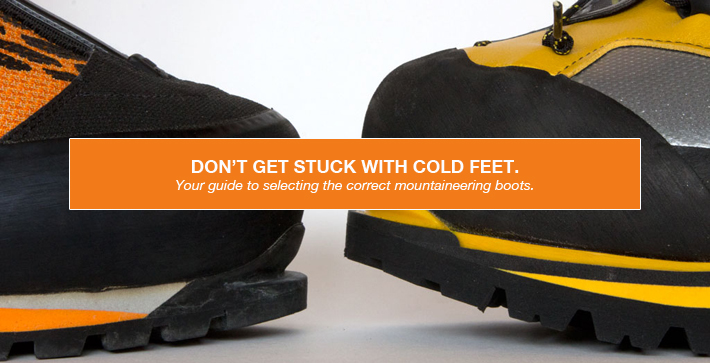
Image from CascadeClimbers.com.
When it comes to spending time outdoors the most important piece of equipment is your footwear. Especially during winter, a good pair of mountaineering boots is imperative. Many wonder, “with myriad options available and so many slight differences between options how do I choose the boot that is best for me?” If this is you, don’t sweat it. Here, I detail the differences and identify what to look for when you are in the market for a new pair of winter mountaineering, ice climbing, rock climbing, or winter hiking boots.
COMFORT
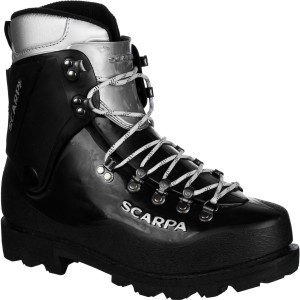
Scarpa Inverno – A double plastic mountaineering boot.
To me, first and foremost – beyond anything else – is comfort. Your boots must fit properly and feel good on your feet. Any compromise here will be unforgettable and inexcusable in the field.
Picture this grim scenario. You are out for a day of climbing in the winter and your poorly fitted boots have caused increasing pain in your feet. It could be a blister, a pressure point, arch pain or other. You are three miles from the trailhead and with every step the pain increases. The only way to make it stop is to get to the trailhead. Getting to the trailhead requires you to keep walking which is the exact cause of the pain in the first place. You can imagine how this plays out…with each step the pain gets worse but the only way to relieve the pain is to keep taking steps. It’s a torturous way to ruin an otherwise awesome day.
Lucky for us, this scenario is easy to avoid. Invest in boots that are comfortable and fit your feet properly. In theory, this sounds easy. In reality, it is not. Consider the following important features when researching and selecting the boots that “feel just right” on you.
Fit
Mountaineering boots come in all shapes and sizes. Some are narrow, some are wide, some have integrated heal locks, some have high arches, some have low, some have laces, some do not. In our rental fleet we have all different brands of double plastic mountaineering boots for this exact reason. We have the ability to sample different brands of the same size so that our clients can find a boot that “feels just right.” Keep in mind that your feet are uniquely yours and finding a pair of boots that fit properly may take a lot of research and time trying on different options. Doing your due diligence upfront will be well worth it in the end, I promise.
Weight
In mountaineering, winter hiking, ice climbing or mixed climbing weight is important. The less weight we carry the more efficient we can be in the mountains. Therefore, something to carefully consider is the weight of your boots. Mountaineering boots are typically heavy – especially compared to trail runners, three-season hiking boots or winter boots for daily use. When buying boots, make sure you check the tech specs. On the lightweight end of the spectrum mountaineering boots weigh between 3-4 pounds (that’s 1.5-2 pounds per foot). Traditionally, the lighter boots tend to be less warm and vise versa. However, with advances in boot design and technology, this isn’t necessarily true anymore. Find a boot that is warm enough for your intended use but doesn’t weigh you down. Remember, do not sacrifice fit for the sake of weight.
Warmth
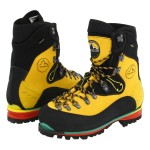
La Sportiva Nepal Evo – A single leather boot.
The most obvious consideration when selecting mountaineering boots is warmth. Cold toes are not fun and they are really easy to identify. Your toes, along with fingers, nose and ears are the first parts of the body to get cold because of low blood flow in cold environments. Therefore, your boots need to be warm enough to keep your toes and feet warm in the harshest weather in which you recreate. Having too warm feet isn’t an issue unless they get oversaturated with sweat – but that is easier to manage. Therefore, I recommend that you aim for the perfect pair of boots for your intended use (but weather and activities change so this is hard to pinpoint) so air on the side of caution and go with extra warm.
Single Versus Double
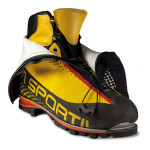
La Sportiva Batura – A single leather boot with integrated gaiter.
Mountaineering boots are designed as either a single boot or double boot. A double boot has an independent, inner liner and an outer shell – a two-piece boot. Single boots do not – they are one-piece boot. Double boots tend to be warmer but they also tend to be heavier. The go-to boot for the recreationalist is a double plastic mountaineering boot. These boots are two-part with an insulating inner boot and a plastic outer shell – 100% waterproof. They are incredibly warm and surprisingly comfortable – commonly compared to a ski boot but less cumbersome. Double plastics are also affordable which makes them attractive to beginners. As you search, you will find that plastics aren’t the only option. In fact, they are a small percentage of what is out there. Many boots are leather – single or double – boots. Leather boots tend to be far more comfortable than a plastic boot but also more pricey. People who own leather boots spend many days in the mountains every winter or price is not a concern. Leather boots come in all shapes and sizes, some warmer than others, some heavier than others, some with integrated gaiters, some without. If leather boots are in your future, then you should spend a lot of time trying on different makes and models until you find the one that “feels just right.”
For instance, I own the Scarpa Phantom Guides. They are the equivalent of the La Sportiva Buturas. Of our guides, we all own one or the other. These boots are a single leather boot with an integrated gaiter (discussed below). They are extremely warm for their light weight. The reason that I chose Scarpa over La Sportiva is simple. The Phantom Guides have a wider toe box. They fit my foot better. This is typical for these brands. Scarpa tends to be wider than La Sportiva. So, when I am shopping for new boots I gravitate toward Scarpa first but never neglect to try La Sportiva too. I do my due diligence because who knows…maybe some day, for some reason the La Sportiva, or other, will suit my fancy. You should do that same. Try on as many brands and models that you can and carefully consider the entire package. Scarpa and La Sportiva are not the only brands available…try them all.
Integrated Gaiter
I previously alluded to an integrated gaiter. Many of you know what a traditional gaiter is or at least have heard of them. They are designed to keep the snow out of your boots and pants. Many of the newer mountaineering boots have begun to integrate the gaiter into the design of the boot. This limits the amount of gear that you need and decreases the weight of your setup. It also adds a tremendous amount of warmth to the boots. To me, it is an incredible advancement in the design of mountaineering boots (this coming from a guy who has 5 right-footed gaiters because I have lost all the lefts). Lightweight boots are now keeping my feet warm because of the integrated gaiter where historically they would not. It is not imperative that your boots have this feature but it is definitely a nice luxury to consider.
PERFORMANCE
We all have different ability levels and the way we recreate in the mountains is not the same. Some people love to winter hike or snowshoe and avoid technical terrain and others prefer to tackle the most advanced challenges possible. Most of us fall somewhere between the two.
Intended Use
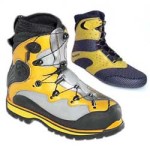
La Sportiva Spantik – A double leather boot.
Identifying your intended use for your mountaineering boots is imperative to selecting the correct pair. This can be difficult since you may partake in many different activities – hiking, ice climbing, mountaineering, mixed climbing, rock climbing or other – and the weather is never the same. For instance, I partake in all of those activities. Each activity requires different equipment, in different environments and requires different levels of physical exertion. Therefore, finding one boot that will perform in a variety of circumstances is hard. Environmental factors and activity level play a huge role in boot selection.
The general recreationalist – one who likes to venture outside but not on a daily or weekly basis – will inevitably prioritize different characteristics in their boots than an outdoor enthusiast or professional who spends every day in the mountains. Hypothetically speaking, if you plan to stay below tree line and only recreate on warmer winter days then warmth isn’t the most important feature of your boots. If you are a technical climber where weight is of the essence or a mountaineer where warmth and weight are critical then you may prioritize different characteristics. In this short hypothetical, you can see how a lot of variables can influence which boots you choose to purchase. Find a pair of boots that matches or intended use. Sometimes, one pair of boots isn’t the solution. I own two pairs.
Crampon compatibility
One often overlooked feature of winter boots is crampon compatibility. Crampons are available with a variety of different binding systems to accommodate a large variety of boot designs. However, putting a crampon on a boot without a rigid sole is incredibly difficult. The crampon tends to ‘pop off’ usually at the most inconvenient times. Making sure that your boot is compatible with your crampons is really important for you safety.
VALUE
Mountaineering boots are expensive. On the cheap side of the scale they will cost around $270 for a new pair of double plastic boots and can cost around $1000 for an 8000m rated boot. Typically, budget drives the decision making process and understandably so. However, do not sacrifice comfort or performance to save a buck. The way we justify the cost is per toe. If you can think about it this way, “the boots aren’t $580 they are $58 per toe” it makes it easier to swallow the upfront investment…at least for me.
You cannot put a price tag on a mountaineering boot that is comfortable and performs well. If your boots keep your feet warm and they “feel just right” then they are worth every penny spent. You can trust me on this one.

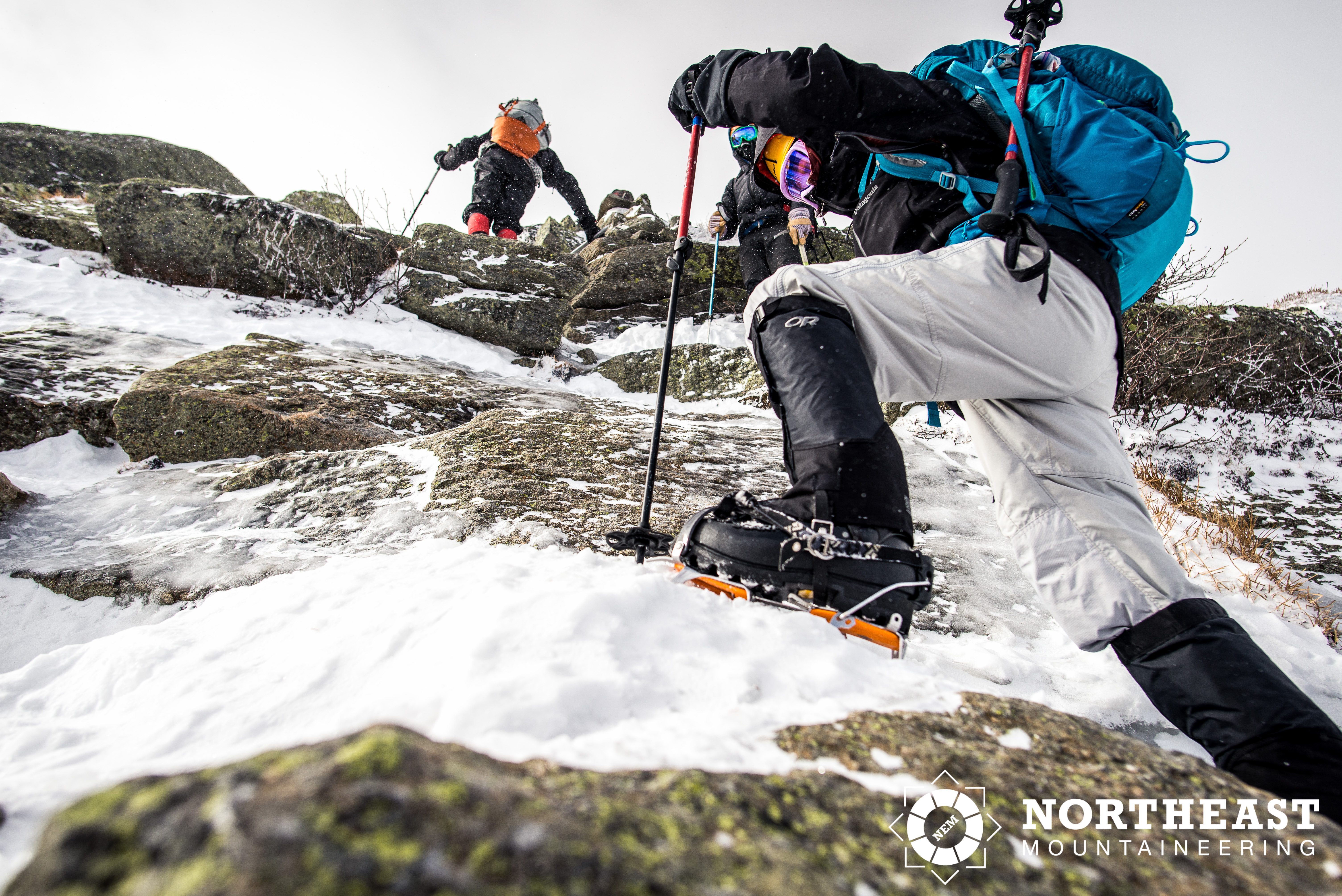
 We are proud to work with the Department of Agriculture, the White Mountain National Forest and the Androscoggin Ranger District where we are authorized outfitter guides.
We are proud to work with the Department of Agriculture, the White Mountain National Forest and the Androscoggin Ranger District where we are authorized outfitter guides.
